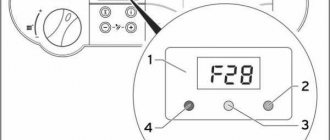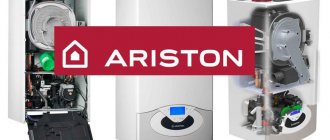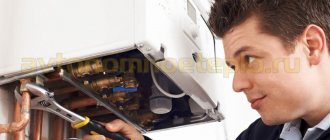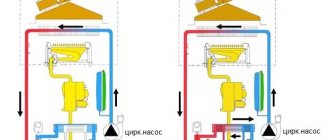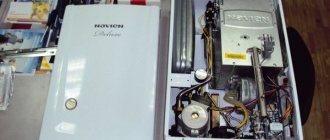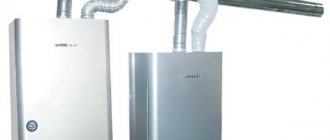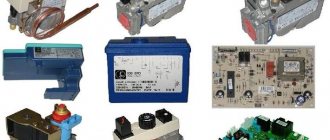Error SP3 or flame separation on the Ariston Egis Plus boiler
When the boiler goes out, various indicators light up, but most often 60 70 80 + chimney icon. Ariston BS boiler
The Ariston brand offers various versions of gas heating equipment; boilers differ in design features and characteristics. But the reasons that trigger the “flame separation” error are identical for all Ariston models. The article tells you what needs to be done to eliminate it.
The burner lights up and goes out
Meaning of the malfunction
It is not difficult to determine the algorithm of actions to eliminate the error, understanding what causes it. There are several reasons for the flame to come off, but if we sum them all up, we can distinguish external and internal ones associated with problems in the Ariston boiler itself. Error 5P3 is a consequence of unstable operation of the burner or failures in the electronic circuit.
External factors causing the error: chimney (excessive or insufficient draft, deficiency of oxygen entering the boiler), supply voltage source, gas supply system.
Problematic components of the Ariston : burner, gas fittings, ionization sensor (control electrode), control board.
Where to begin
- Press the reset button (on the front panel of the boiler). Depending on the version, Ariston is designated as R or REZET. In most cases, the flame out error disappears.
Ariston EGIS PLUS boiler control panel. Click the Reset button.
Ariston bs 24 boiler control panel. Press the Reset button.
Ariston CARES X 24 FF boiler control panel. Click the Reset button.
- Check voltage. The electronics of some heating system models are phase dependent. If the boiler is connected to the electrical network directly, through a socket, you need to pull out the plug, turn it 1800 and insert it again. When connecting it to the power source with a cable, the wires (cores) L and N should be swapped.
Pull out the plug, turn 180 degrees and plug back into the outlet.
- Make sure that the power supply parameters comply with the values recommended by the manufacturer. For Ariston boilers this is ~230 V: deviation from the nominal value is no more than ±10%.
The risks of errors occurring in a gas boiler (and not just flame retardation) are mitigated by connecting it to a UPS. Advice on installing a separate stabilizer for Ariston is of little use - the device functions only with a continuous power supply. If we are talking about a country property, it is better to purchase a power supply for the boiler. It contains, in addition to the voltage equalization circuit, a charger and a battery group. Even if there are breaks on the power lines or failure of the backup power source, the heating installation will not turn off, and the house will not be left without heat.
- Check the reliability of the grounding. Ariston models often give various errors when the wire is in unreliable contact with the device circuit.
- Carefully inspect the inside of the boiler. According to repair statistics, up to 70% of errors are caused by violations in signal lines and power circuits: wire breaks or short circuits, insulation damage (breakdowns to the housing), unreliable connections (weak or oxidized contacts). Perhaps this is the problem with the flame separation of the Ariston boiler.
Flame separation from the burner and breakthrough.
⇐ PreviousPage 5 of 26Next ⇒
Flame separation from the burner will occur if the flow rate of the hot water supply (gas-air mixture) is greater than the speed of flame propagation. In this case, the flame shortens, moves away from the mouth of the burner, can come off completely and the firebox can become gassy.
Flame separation from the burner can occur due to excessive draft in the chimney, when gas is supplied at a higher speed, or with high pressure of hot water entering the burner.
Separation can occur when the burner is ignited or when part of the burners is turned off. Do not supply gas and air pressure to the burner greater than that indicated in the burner data sheet.
Flame penetration into the burner will occur if the speed of hot water flow is less than the combustion speed - flame propagation. The slip is accompanied by a bang. In this case, flames fly out through all the holes in the burner and the operator may get burned.
Flame breakthrough is most likely in burners that have a gas-air mixture inside, i.e. gas and air. These are injection burners and with forced air supply (kinetic).
If the flame penetrates the burner, it overheats, may fail, and the firebox may gas. Flame breakthrough is possible due to poor draft, as well as when pressure is supplied to the DHW burner at a pressure less than indicated in the burner data sheet. Overshoot is possible when the burner productivity decreases, when the injection burner is turned off with the primary air regulator open, or when the burner is overheated.
If it comes off or leaks, you must immediately shut off the gas supply to the burner, and then find out the reason and relight it according to the instructions.
Methods for stabilizing a burner flame in a furnace
The limits of stable operation of burners are the separation of the flame from the burners and the penetration of the flame into the burner.
Flame stabilization is carried out using special devices and creating conditions to prevent separation or breakthrough:
· Maintaining the DHW output speed within safe limits;
· Maintaining the temperature in the combustion zone not lower than the ignition temperature of the hot water supply.
When pure gas without air enters the burner, the flame in this case is most stable, because there can be no breakthrough, and separation is unlikely, because Such devices operate at low gas pressure.
In burners that have a ready-made gas-air mixture, i.e. gas and air, separation and breakthrough are possible. Flame penetration into the burner can be prevented if:
· Reduce the outlet for DHW;
· At the mouth of the burner, install a slot stabilizer with a slot size of no more than 1.2 mm or a mesh with a fine mesh, no more than 2.5 mm in size;
· If you cool the burner outlet.
Flame separation from the burner can be prevented by installing a constantly burning pilot burner at the burner mouth, using refractory tunnels of various designs, installing a cutting stabilizer, and installing a refractory slide made of refractory bricks in the boiler furnace. The slide (fireproof) in the firebox prevents the flame from breaking off and maintains the temperature in the boiler firebox.
HEAT BURNER
A device consisting of a perforated gas manifold made of a steel pipe and placed along the axis of a rectangular channel made of fire-resistant materials. The hearth burner operates on the diffusion principle. Gas, without preliminary mixing, flows out of two rows of holes (the distance between the centers of the holes in a row is 15-26 mm) and forming an angle of 90 with each other. Air is supplied through the grate from the plenum space under the gas manifold by a fan or enters there due to vacuum in the firebox, passes in the channel, washing the gas manifold on both sides, which is installed strictly along the axis of the tunnel. Gas streams, as a result of turbulent diffusion, intensively mix with air, and the combustion process begins at a distance of 20-40 mm from the collector holes. The length of the hearth burner torch (0.5-1 m) requires an appropriate firebox height. The completeness of gas combustion in burners of this type depends on the ratio of gas and air velocities, the diameters of the gas holes, the distance between them, the size, shape and quality of the channel laying, and the vacuum in the furnace.
Advantages of hearth burners: 1) quiet operation and a wide range of performance control; 2) if there is a vacuum in the furnace of more than 3 mm of water. Art. At full or reduced load, the burners can be operated without forced air supply.
Disadvantages of hearth burners: 1) in fully screened fireboxes, installing burners requires cutting out part of the screens or installing screen pipes; 2) when the burners are located near the screen surfaces, the pipes may be cut by the torch; 3) significant temperature unevenness in the horizontal section of the furnace and frequent failure of the lining.
⇐ Previous5Next ⇒
Recommended pages:
How to find the cause of the error
You need to start by testing external systems and devices: breakdowns in Ariston boilers are a rare occurrence.
Chimney
It is not difficult to check the draft: if it is excessive, flame separation is observed; if it is insufficient, a so-called breakthrough occurs, accompanied by a characteristic pop. Incomplete blockage of the tract (clogging) can be easily eliminated using available means.
If a coaxial chimney is installed, you need to inspect the outer part of the duct. Freezing in winter blocks the air supply channel to the boiler. Its lack affects the quality of the combustible mixture, the operation of the burner is disrupted, hence the Ariston flame separation error.
Coaxial chimney with protection from the external environment
Recommendations
- Models with an open chamber should ensure a sufficient flow of oxygen into the room. If flame separation is eliminated by completely opening doors and windows, you will have to install a forced air supply system.
- The appearance of an error during the initial start-up of the Ariston boiler indicates miscalculations made during the design and installation of the smoke exhaust duct. Here you cannot do without consulting a professional. Possible problems: incorrectly selected path length and height of the first bend (for models with an open chamber), small pipe cross-section, unnecessary turns.
Gas main
Error 5P3 of the Ariston boiler appears when the pressure value does not correspond to the standard value. The optimal ratio of gas and air in the combustible mixture is violated, which leads to flame separation or breakthrough. There are several reasons that initiate a problem with pressure in the pipe.
- Significant temperature fluctuations , non-compliance of the characteristics of “blue fuel” with the requirements of the boiler manufacturer Ariston.
- Glaciation on the highway. Typical for facilities with an autonomous gas supply system. As a rule, the problem is in the gearbox, the operation of which is blocked by the formed ice. But simply warming it up is not enough - you need to additionally insulate the head of the gas tank or an outdoor cabinet with a cylinder group. Otherwise, the Ariston boiler error “flame separation” will appear regularly.
Gas cylinders for gas boiler
Burner
One of the reasons for flame separation is its instability, caused by the low intensity of the gas entering the chamber from the nozzles. Over time, they become clogged with particles of soot and dust. It is enough to clean the burner, and the Ariston boiler flame failure error will disappear from the display. The work is being carried out in stages.
Burner clogged with dirt and dust
- Heat exchanger maintenance. It is located above the burner, and gradually microscopic fractions stick to the body of the device (in the lower part), rising along with the flame. The technique is simple: the burner is covered with a sheet, film or piece of dense fabric to prevent dirt and dust from getting on the nozzles. Next, mechanical treatment of the ribbed surface of the heat exchange device with a stiff brush (a toothbrush will do). Everything that falls down onto the laid material is disposed of.
- Boiler burner maintenance. Its injectors also require regular cleaning. You will need a vacuum cleaner and the same toothbrush.
Ionization sensor
From it, a signal about the presence of a flame is sent to the control board, which confirms the correct functioning of the Ariston boiler; if not present, the work is blocked. In some models, the sensor and control electrode are separated, but the meaning of the flame failure error does not change.
What to do
- Clean the electrode. All layers are carefully removed with “velvet” sandpaper: burnt dust, soot.
- Make sure the electrode is in the correct position. The wire cannot be bent - it is fragile, only the holder bar.
Ariston boiler ionization sensor
If the measures taken to restore the functionality of the Ariston boiler do not give a positive result, the ionization sensor is changed.
There are other reasons for the flame-out error of an Ariston boiler, but you shouldn’t deal with them yourself - only a professional approach. And no matter what numerous advisers claim, you need to understand the difficulties that you will have to face.
Gas valve
In the instructions for individual models of Ariston boilers, there are recommendations for its adjustment: but this is for professionals. When setting up the unit, you need a special device - a differential pressure gauge. Therefore, all independent attempts are doomed to failure in advance. Perhaps the flame separation error will disappear, but side effects will arise: malfunctions in the operation of the boiler when the mode changes, increased consumption of “blue fuel” and a number of others.
Electronic board.
At home, even a professional will not undertake to test it, much less carry out repairs - you need the appropriate equipment and tools.
The concept of flame breakthrough and methods of dealing with it.
a) Flame breakthrough (backfire) is the penetration of the flame into the burner. This phenomenon occurs when the speed of flow of the gas-air mixture from the burner is less than the speed of flame propagation. Most often, slippage occurs when the burner is improperly ignited and switched off, as well as when its performance quickly decreases. Flame breakthrough can only occur with burners with pre-mixing of gas and air.
b) Control method: cooling the burner tunnel.
Causes of flame breakthrough and separation.
The reasons for flame penetration into the burner are a decrease in gas or air pressure, a decrease in burner productivity below the values specified in the passport
The reasons for the flame to come off the burner are a sharp increase in gas or air pressure, a violation of the gas-air flow ratio, a sharp increase in the vacuum at the outlet of the furnace, an increase in burner productivity above the values specified in the passport.
Types of flame stabilizers.
a) Gas flame stabilizers. The most common flame stabilizers are conical and cylindrical tunnels, used when installing various types of burners. In tunnels, flame stabilization is ensured by the high temperature and high emissivity of the tunnel surface. In addition, zones of reverse currents (recirculation) or turbulence of part of the combustion products, which have a high temperature and contribute to the ignition of the gas-air mixture flowing from the burner, are created in the tunnels.
b) Gas heating boilers
Environmental problems when burning gases and other types of fuel.
Gas emissions contain nitrogen and sulfur oxides. When dissolved in atmospheric air, acid precipitation is formed, which leads to acidification of snow and soil cover, precipitation of nitrates and sulfates.
As for the harmful effects on the soil, the total area of disturbed soil from the impact of emissions from burning torches is about 100 thousand hectares. Near the torches, when exposed to high temperatures, almost complete burning occurs.
For forest ecosystems, the most typical negative consequences are the reduction of forests, an increased risk of forest fires near flares, and a decrease in the number of animals, insects and microorganisms.
Formation of soot and carbon monoxide during combustion.
Carbon monoxide is contained in the combustion products of the listed substances in the largest quantity. The scheme of formation and burnout of CO has the following character: in the initial section of burnout there is an accumulation of CO, and then its oxidation along the length of the torch or combustion chamber. High concentrations of CO remain if combustion products “freeze”, i.e. rapid cooling due to expansion or contact with relatively cold heat transfer surfaces.
(In the atmosphere, carbon monoxide is oxidized to dioxide.)
Soot is found in the combustion products of hydrocarbon gases with low quality of mixture formation and with a significant lack of oxygen in the combustion zone, as well as due to sharp local cooling of the flame. The reason for the formation of soot is that under the influence of high temperature, hydrocarbon molecules are completely destroyed. The lighter hydrogen atoms diffuse into the rich oxygen layer and become oxidized. And carbon atoms form amorphous soot particles.
Formation of nitrogen oxides during combustion of gases.
Nitrogen oxides are formed in industrial furnaces at high temperatures of 1800-2000 °C. Typically the concentration of NO
when leaving the chimney it exceeds the maximum permissible concentration by 1000-20000 times.
After leaving the chimney, nitrogen oxide turns into NO
2 dioxide through two reactions:
1 Oxidation with oxygen occurs at the root of the smoke plume
2NO
+
O
2 = 2
NO
2
2 At low concentrations, oxidation occurs due to atmospheric air
NO
+
O
3 =
NO
2 +
O
2.
39. Thermal mechanism Ya.B. Zeldovich formation of NO during combustion
The high-temperature mechanism of nitrogen oxidation in the combustion zone was proposed by Ya. B. Zeldovich in the mid-1940s and is considered the main mechanism for the formation of nitrogen oxides during combustion. This mechanism includes the following elementary stages:
to which is added the reaction (Fenimore and Jones, 1957):
The set of reactions (1-3) is called the extended Zeldovich mechanism. Due to the fact that the energy of the triple bond in the N2 molecule is about 950 kJ/mol, reaction (1) has a high activation energy and can occur at a noticeable rate only at high temperatures. Therefore, this mechanism plays an important role in the case of high temperatures in the reaction zone, for example, during the combustion of near-stoichiometric mixtures or during diffusion combustion. It is believed that an increase in the maximum temperature in the combustion zone above 1850 K leads to unacceptably high NO x emissions, and one of the main ways to reduce emissions by the thermal mechanism is to prevent the formation of hot spots in the flame front.
Formation of carcinogenic PAHs during combustion.
Polycyclic aromatic hydrocarbons are an undesirable by-product of burning fossil fuels, primarily coal and petroleum products. Coal is considered to be a mixture of a huge amount of polycondensed aromatic benzene nuclei with a minimal hydrogen content. When these substances are burned in furnaces, power plants, and internal combustion engines, these compounds decompose. At low combustion temperatures and insufficient supply of atmospheric oxygen, highly reactive acetylene is formed, as well as various aliphatic hydrocarbon fragments. Acetylene polymerizes to butadiene, which further forms the aromatic hydrocarbon core. When it is added to existing aromatic nuclei, a PAH is created, such as pyrene, from which the most famous carcinogen, benzo[a]pyrene (BaP), is released by adding another molecule of butadiene. When burned at high temperatures and with plenty of atmospheric oxygen, few PAHs are formed because virtually all the carbon is burned to carbon monoxide.
Incomplete combustion produces carbon particles called soot. It can be assumed that the resulting PAHs, adsorbed on the surface of soot and smoke particles, enter our environment with them. Soot, solid particles of smoke and exhaust gases are found in road dust, smog in large cities, and dusty air from coke plants. Together with dust, they get onto clothes, skin, and into the respiratory tract. Today, several hundred different polycyclic aromatic substances are already known: several dozen of them are carcinogens. However, their effect is different and depends on the structure of the corresponding substance.
Conclusion:
Taking into account the cost of the Ariston boiler, it is not advisable to take excessive initiative in identifying and eliminating the flame separation error on your own. Everything that is recommended for the user to check and perform is indicated in the article. There is no result - call a representative of the service organization.
Practical advice
- A one-time visit from a technician due to a problem with the boiler is expensive. On thematic forums you can find the following data: 5000 rubles for eliminating the flame separation error. It is more expedient to conclude an annual maintenance agreement with a service center (cost about 2500). The benefit is double – significant money savings and professional service.
- Experts recommend mitigating the risk of electrical interference on the gas main. For this reason, the control circuit of Ariston boilers often gives failures and errors. In some cases, the program is broken, and the board has to be reflashed. This problem can be avoided by installing dielectric inserts on the pipe (in several places); with professional installation this is done immediately.
- When connecting an Ariston boiler to a gas tank, you need to choose the right supplier of “blue fuel” and conclude an agreement with him. If the flame separation error is caused by low quality LPG, there will be someone to file a formal claim and compensate for possible damage (both moral and material). And one-time calls to fill the reservoir of representatives of little-known organizations, even those offering a low price, should not be practiced. Solving possible problems with the operation of the Ariston boiler will ultimately cost more.
